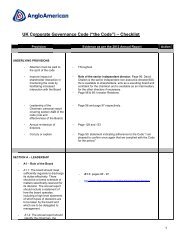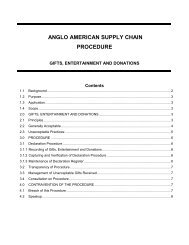Anglo American Annual Report 2012
Anglo American Annual Report 2012
Anglo American Annual Report 2012
- No tags were found...
Create successful ePaper yourself
Turn your PDF publications into a flip-book with our unique Google optimized e-Paper software.
1. ACCOUNTING POLICIES continuedForeign currency transactions and translationForeign currency transactions by Group companies are recognised in thefunctional currencies of the companies at the exchange rate ruling on the dateof the transaction. At each reporting date, monetary assets and liabilities thatare denominated in foreign currencies are retranslated at the rates prevailingon the reporting date. Gains and losses arising on retranslation are included inthe income statement for the period and are classified as either operating orfinancing depending on the nature of the monetary item giving rise to them.Non-monetary assets and liabilities that are measured in terms of historicalcost in a foreign currency are translated using the exchange rate at the dateof the transaction.On consolidation, the assets and liabilities of the Group’s foreign operationsare translated into the presentation currency of the Group at exchange ratesprevailing on the reporting date. Income and expense items are translated atthe average exchange rates for the period where these approximate the ratesat the dates of the transactions. Any exchange differences arising areclassified within the statement of comprehensive income and transferred tothe Group’s cumulative translation adjustment reserve. Exchange differenceson foreign currency balances with foreign operations for which settlement isneither planned nor likely to occur in the foreseeable future and thereforeform part of the Group’s net investment in these foreign operations are offsetin the cumulative translation adjustment reserve.Cumulative translation differences are recycled from equity and recognisedas income or expense on disposal of the operation to which they relate.Goodwill and fair value adjustments arising on the acquisition of foreign entitiesare treated as assets of the foreign entity and translated at the closing rate.Presentation currencyAs permitted by UK company law, the Group’s results are presented in USdollars, the currency in which its business is primarily conducted.Borrowing costsInterest on borrowings directly relating to the financing of qualifying capitalprojects under construction is added to the capitalised cost of those projectsduring the construction phase, until such time as the assets are substantiallyready for their intended use or sale which, in the case of mining properties,is when they are capable of commercial production. Where funds have beenborrowed specifically to finance a project, the amount capitalised representsthe actual borrowing costs incurred. Where the funds used to finance aproject form part of general borrowings, the amount capitalised is calculatedusing a weighted average of rates applicable to relevant general borrowingsof the Group during the period. All other borrowing costs are recognised inthe income statement in the period in which they are incurred.Share-based paymentsThe Group has applied the requirements of IFRS 2 Share-based Payment.In accordance with the transitional provisions, IFRS 2 has been applied to allgrants of equity instruments after 7 November 2002 that had not vested as at1 January 2005.The Group makes equity settled share-based payments to certain employees,which are measured at fair value at the date of grant and expensed on astraight line basis over the vesting period, based on the Group’s estimate ofshares that will eventually vest. For those share schemes with market relatedvesting conditions, the fair value is determined using the Monte Carlo methodat the grant date. The fair value of share options issued with non-market vestingconditions has been calculated using the Black Scholes model. For all othershare awards, the fair value is determined by reference to the market value ofthe shares at the grant date. For all share schemes with non-market vestingconditions, the likelihood of vesting has been taken into account whendetermining the relevant charge. Vesting assumptions are reviewed duringeach reporting period to ensure they reflect current expectations.Black economic empowerment (BEE) transactionsWhere the Group disposes of a portion of a South African based subsidiaryor operation to a BEE company at a discount to fair value, the transaction isconsidered to be a share-based payment (in line with the principle containedin South Africa interpretation AC 503 Accounting for Black EconomicEmpowerment (BEE) Transactions).The discount provided or value given is calculated in accordance with IFRS 2and included in the determination of the profit or loss on disposal.Employee benefit trustShares held by the employee benefit trust are recorded as own shares,and the carrying value is shown as a reduction within shareholders’ equity.Financial instrumentsFinancial assetsCash and cash equivalentsCash and cash equivalents comprise cash in hand and on demand deposits,together with short term, highly liquid investments that are readily convertibleto a known amount of cash and that are subject to an insignificant risk ofchanges in value. Bank overdrafts are shown within short term borrowings incurrent liabilities on the balance sheet. Cash and cash equivalents in the cashflow statement are shown net of overdrafts. Cash and cash equivalents aremeasured at amortised cost.Trade receivablesTrade receivables do not incur any interest, are principally short term in natureand are measured at their nominal value (with the exception of receivablesrelating to provisionally priced sales, as set out in the revenue recognitionaccounting policy), net of appropriate allowance for estimated irrecoverableamounts. Such allowances are raised based on an assessment of debtorageing, past experience or known customer circumstances.InvestmentsInvestments, other than investments in subsidiaries, joint ventures andassociates, are financial asset investments and are initially recognised at fairvalue. At subsequent reporting dates, financial assets that the Group has theexpressed intention and ability to hold to maturity (held to maturity) as well asloans and receivables are measured at amortised cost, less any impairmentlosses. The amortisation of any discount or premium on the acquisition ofa held to maturity investment is recognised in the income statement in eachperiod using the effective interest method.Investments other than those classified as held to maturity or loans andreceivables are classified as either at fair value through profit or loss (whichincludes investments held for trading) or available for sale financial assets.Both categories are subsequently measured at fair value. Where investmentsare held for trading purposes, unrealised gains and losses for the period areincluded in the income statement within other gains and losses. For availablefor sale investments, unrealised gains and losses are recognised in equity untilthe investment is disposed of or impaired, at which time the cumulative gain orloss previously recognised in equity is included in the income statement.Current financial asset investments consist mainly of bank term deposits andfixed and floating rate debt securities. Debt securities that are intended to beheld to maturity are measured at amortised cost, using the effective interestmethod. Debt securities that are not intended to be held to maturity arerecorded at the lower of cost and market value.Impairment of financial assets (including receivables)A financial asset not measured at fair value through profit or loss is assessedat each reporting date to determine whether there is any objective evidencethat it is impaired. A financial asset is impaired if objective evidence indicatesthat a loss event has occurred after the initial recognition of the asset.An impairment loss in respect of a financial asset measured at amortised costis calculated as the difference between its carrying amount and the presentvalue of the estimated cash flows discounted at the asset’s original effectiveinterest rate. Losses are recognised in the income statement. When asubsequent event causes the amount of impairment loss to decrease, thedecrease in impairment loss is reversed through the income statement.Impairment losses relating to available for sale investments are recognisedwhen the decline in fair value is considered significant or prolonged.These impairment losses are recognised by transferring the cumulativeloss that has been recognised in the statement of comprehensive incometo the income statement. The loss recognised in the income statement isthe difference between the acquisition cost and the current fair value.Financial statements<strong>Anglo</strong> <strong>American</strong> plc <strong>Annual</strong> <strong>Report</strong> <strong>2012</strong> 145



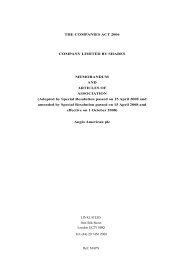
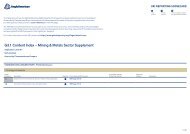
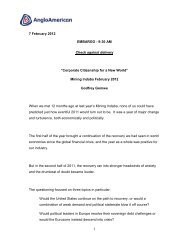


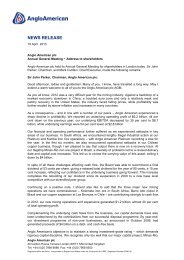
![English PDF [ 189KB ] - Anglo American](https://img.yumpu.com/50470814/1/184x260/english-pdf-189kb-anglo-american.jpg?quality=85)



![pdf [ 595KB ] - Anglo American](https://img.yumpu.com/49420483/1/184x260/pdf-595kb-anglo-american.jpg?quality=85)
![pdf [ 1.1MB ] - Anglo American](https://img.yumpu.com/49057963/1/190x240/pdf-11mb-anglo-american.jpg?quality=85)
